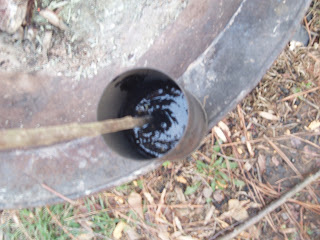Making Glue From Three Ingredients
Glue of this type should be used to handle light duty projects like making fish hooks, hafting arrow heads and so on. In a later article I'll talk about how to make a wilderness super glue. In order to make this handy option to surviving in the wilderness, you will need a metal container...
... powdered charcoal, deer or rabbit droppings, and hardened pine sap. Deer scat is one of the hardest ingredients to find out of all the ingredients. You don't want to aimlessly want to start looking around on the ground to find some.
Put the pine sap into the container.
Heat it on the fire until it melts.
Stir it up to help it liquefy.
Add some powdered charcoal into the molten sap.
Stir it in together. If the mixture starts to harden just put it back on the fire until it liquefies again. You want to keep it in a liquid state so you can get all the ingredients to mix well.
Now add the deer droppings to the mix. I used some makeshift chopsticks to put it in the cup without having to touch it with my hands. It may seem odd to be using deer poo as an ingredient, but the digested plant material keeps the glue from being too brittle when it's finished. If you don't like messing with deer poo you can use sawdust but the droppings do tend to work better.
You would think, ok, I'm cooking poo in a can, it must smell horrible! In fact, it doesn't smell like anything at all. So the good news is that instead of attracting a terrible stench, you get more out of this product than an aftertaste of deer poo clinging to the air.
As far as comparing the two ingredients of poo, sawdust, or finely ground plant matter, the thing to remember is that the plant matter is there to keep the glue from being too brittle. You can compare this to modern fiberglass. The fabric is impregnated with a resin which gives you a strong composite. The plant matter from the droppings is like that fabric. The only difference is that this is used as a glue to bond things together and should not be used as a fiberglass. The advantage of using animal droppings as opposed to saw dust is that the poo naturally dries hard which will give your glue that much more strength.
Put back on the fire and stir it up until it mixes well.
Dip a stick into the glue and roll it in layers on a piece of metal or glass in order to cool the surface and mold it onto the stick. Repeat layer by layer until all the glue is on the stick.
This is the finished glue on a carry stick. This is for easy transport.
It looks like glass and feels like glass. It's pretty much like having a melted beer bottle on a stick. This glue made up of pine sap, powdered charcoal, and deer poo will keep indefinitely. Having used the deer droppings as one of the ingredients doesn't make the glue unsanitary because of the way it was prepared. In heating up the glue to a boil, it will kill any pathogens it might have had. In addition to that, pine sap is a natural antiseptic.
Again, this is by no means super glue. This should be used to handle light duty projects like making fish hooks, hafting arrow heads and so on. In a later article I'll talk about how to make a wilderness super glue.
An example of this glue being used as a tool can be found here for this Laotian Bird Trap. The glue connects the two pins to the cordage and also keeps the bird seeds on the bait stick.
Since the glue is hard like glass it makes for easy transportation. When holding it, don't worry about it sticking to anything when it's hard. When you are ready to use the glue, hold a small flame to it just enough to let it drip onto what you need in order for it to bond. Get it gummy enough to smear it to the surface you want glued.
Another thing to note about this glue is it is very flammable so be careful when heating it up for use or when making it.



























